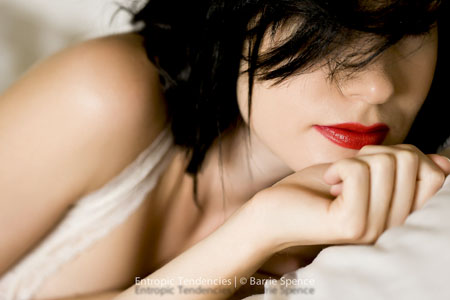Lighting for boudoir work is critical - as always. Keep it as soft and warm as possible because this flatters the model and avoids harsh highlights on the skin and ugly shadows. However, make sure that contrast is properly controlled to give depth, texture etc. Large umbrellas and softboxes produce good lighting when correctly positioned.
Keep the lighting as simple as possible. Models pick up very quickly any lack of confidence on the part of the photographer and this makes them feel unsure of what they are doing. Don't spend time fiddling with lighting sets, exposures etc, just get on with it and concentrate attention on the model.
 |
| Image by kind permission of Barrie Spence of Entropic Tendencies |
Indirect and low light tend to produce an appropriately intimate atmosphere. Alternatively, when focusing attention on the face, head and shoulders, use a single light directed towards the model's face, and allow the rest of the body to fade in to shadow. For full-length shots, pose the model directly across the frame so that head, and legs are all sharp. Position a main light somewhere around the eye level of the model and use back-lighting to highlight the outline of the body and legs. For a more dramatic look, try a silhouette effect. Keep the main light reasonably high and use back-lighting behind the model. Parts of the body can be rendered in near silhouette to highlight curves but, in general, keep the face illuminated.
Backgrounds are best kept subdued. Black or dark coloured drapes focus attention on the model. Props should be in good condition and appropriate to the atmosphere of the shots. Take care of details that seem unimportant at the time of the shoot but may turn out to be important in the final images. Is the model's preparation well executed? Are any accessories out of position or inappropriate?
Natural light works well and may be appropriate. Much depends upon the mood of the images and the location being used. Window light can be wonderful provided no direct sunlight falls on the model to burn out patches of skin.
All boudoir images should be examined closely for skin blemishes that can be corrected in Photoshop. Take care with this because some people are sensitive about being "improved" on a computer. Moles, dimples and similar features should be checked with the model before any modifications are made.






